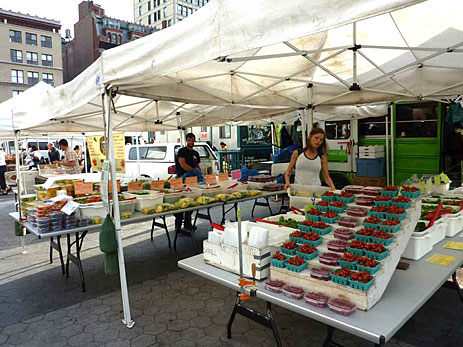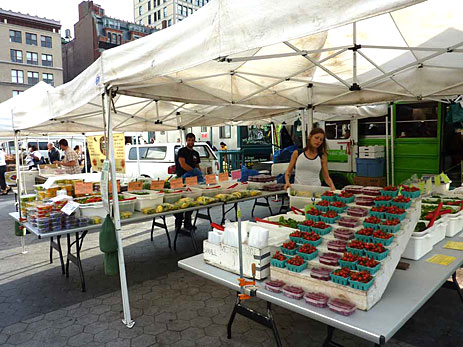 Farmer Morse Pitts’ stall at the Greenmarket.(Windfall Farm blog)In the cover piece of the newest American Prospect, Heather Rogers skillfully makes a point I’ve been flogging for years: that public policy, not consumer choice, is the villain propping up the industrial food system and constraining the growth of organic farming.
Farmer Morse Pitts’ stall at the Greenmarket.(Windfall Farm blog)In the cover piece of the newest American Prospect, Heather Rogers skillfully makes a point I’ve been flogging for years: that public policy, not consumer choice, is the villain propping up the industrial food system and constraining the growth of organic farming.
Rogers, author of the new book Green Gone Wrong: How Our Economy Is Undermining the Environmental Revolution, opens with the example of a New York State farmer named Morse Pitts. He sells the bounty of his 15-acre Windfall Farm in the Hudson Valley at Manhattan’s famed Union Square market, where his eggs command a steep $14 per dozen and “some of his greens go for more than $40 per pound.” Yet even though his weekly market stand teems with consumers eager to “vote with their forks” (to speak nothing of their checking accounts), he nets just $7 per hour for his labor and plans to shut down his operation soon.
The problem, Rogers makes clear, is a widespread lack of infrastructure for supporting small-scale, ecologically minded farmers. The public resources that might do just that are siphoned off by the industrial food system, in the form of commodity subsidies and largesse to the corn ethanol industry. Farmers like Pitts have to pass on the costs of their ecological stewardship directly to their customers in the form of eye-popping prices, which still don’t add up to a decent salary, while industrial-scale farms can generally trash the environment with impunity, letting society as a whole, or distant communities, pick up the bill. See, for example, the Gulf of Mexico Dead Zone.
At this point, farmers like Pitts — whose experience aligns with my own efforts to farm in North Carolina — have plenty of conscientious consumers willing to pay the full cost of their food. What they need now are conscientious policymakers willing to take on the agribusiness and food-processing interests that profit most from the current situation.
President Obama is not passing muster on this front, Rogers argues. Sure, he placed organic-friendly Kathleen Merrigan in a high post at USDA, and the First Lady has energetically promoted the consumption of local fruits and vegetables over industrially produced, highly processed garbage. But the president remains committed to mass-scale, chemical-intensive farming as the dominant thrust of U.S. agriculture. Anyone who doubts that will have to explain Obama’s stated goal, flagged by Rogers, of doubling exports of commodity crops like corn and soy over the next five years. The man clearly wants to ramp up, not dismantle, industrial agriculture. (See also his tapping of high-profile reps from the pesticide and GMO industries for key ag-policy jobs.)
I agree with Rogers’ assessment, with a caveat. Even if Obama were serious about transforming the food system (which I don’t think he is), he would have to contend with a set of highly profitable incumbent industries, from agrichemical makers to cheeseburger purveyors, that will defend their interests by fang and claw on Capitol Hill. And their immense lobbying power leaves any would-be reformer in the White House with little room to impose change.
Of Agriculture Secretary Tom Vilsack, Rogers writes “he commands a $134 billion annual budget that includes agriculture subsidies, the National Organic Program, and food-stamp and nutrition programs.” True, but Vilsack has very little discretion over how that cash hoard is spent. The USDA chief mostly executes farm policy made in the House and Senate ag committees, and those entities are notoriously captured by the Big Ag and Big Food lobbies.
Just as healthcare reform could not move through Congress without making stark concessions to the insurance industry, just as even highly compromised climate legislation has been throttled by dirty-energy interests; and just as efforts to impose financial reform languish under the boot of Wall Street and its kept politicians, any serious presidential effort to reform the food system will crash into a brick wall constructed by the likes of Monsanto and Tyson Food.
Which brings us back to the role of consumers. Voting with your fork, it turns out, is not enough. We can’t just “be the change we want to see” in the food system; we also have to get out there and organize for policy reform: to become, in short, a countervailing force that challenges the power of the food lobby.
Easier said than done, of course, and a tall order at a time of 10 percent unemployment and falling wages. My own mother once confronted me with this: “Not only do I have to pay more for my food, but now I have to attend food-policy council meetings in my highly limited free time?” she complained.
The answer is yes, for those who have resources to invest in those or other things. If you want to see real change, for farmers like Pitts not to have to charge $14 for eggs and still be in the red, for the average American to be able to afford food grown by values such as his — that’s the only way it’s going to happen.



